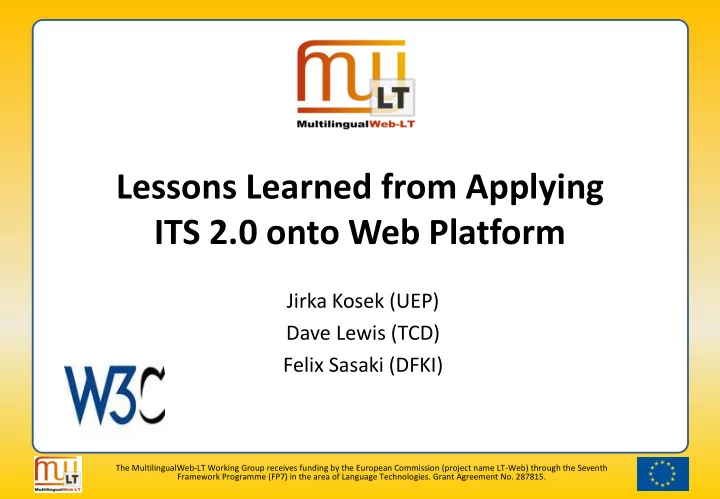

Lessons Learned from Applying ITS 2.0 onto Web Platform Jirka Kosek (UEP) Dave Lewis (TCD) Felix Sasaki (DFKI) The MultilingualWeb-LT Working Group receives funding by the European Commission (project name LT-Web) through the Seventh Framework Programme (FP7) in the area of Language Technologies. Grant Agreement No. 287815.
What is ITS 2.0? • Meta-data annotations addressing gaps in I18n and L10n interoperability – CMS, L10n Tools, Language Technology • Defines 18 separate Data Categories • Implementation-neutral specification of data categories • Implementations in HTML5, XML and RDF The MultilingualWeb-LT Working Group receives funding by the European Commission (project name LT-Web) through the Seventh Framework Programme (FP7) in the area of Language Technologies. Grant Agreement No. 287815.
ITS 2.0 Data Categories Language Provenance & ITS1.0 I18n Technology QA • Translate • Locale Filter • Domain • Quality Issue • Localization • External • MT • Quality Note Resource confidence Rating • Terminology • Preserve • Text Analysis • Provenance Space • Directionality • Allowed • Lang info Characters • Element • Storage Size within text • ID Value The MultilingualWeb-LT Working Group receives funding by the European Commission (project name LT-Web) through the Seventh Framework Programme (FP7) in the area of Language Technologies. Grant Agreement No. 287815.
ITS 2.0 examples • Namespaced attributes are used for capturing ITS metadata in XML documents <para> See you in <phrase its:term="yes" > Berlin </phrase> . </para> <para> But there are other cities to go if you like <phrase its:translate="no" > foie gras </phrase> . </para> • In HTML5 its-* prefixed attributes are used <p> See you in <span its-term="yes" > Berlin </span> . </p> The MultilingualWeb-LT Working Group receives funding by the European Commission (project name LT-Web) through the Seventh Framework Programme (FP7) in the area of Language Technologies. Grant Agreement No. 287815.
Problems we faced in Web Platform • CSS selectors can not address attributes and thus can not replace XPath even for quite simple and common scenarios (e.g. title attribute) • HTML5 extensibility is very limited and implementing its-* prefixed solution is more expensive then using namespaces (e.g. updating validator) • HTML5 does not have feature for embeding XML islands with additional (meta)data The MultilingualWeb-LT Working Group receives funding by the European Commission (project name LT-Web) through the Seventh Framework Programme (FP7) in the area of Language Technologies. Grant Agreement No. 287815.
What is missing for smooth workflow • Majority of websites is managed in CMS • Easy way for importing/exporting content together with ITS annotations, translation memory, terminological vocabulary, … is needed for localization interoperability • CMIS (Content Management Interoperability Services) profile could be solution The MultilingualWeb-LT Working Group receives funding by the European Commission (project name LT-Web) through the Seventh Framework Programme (FP7) in the area of Language Technologies. Grant Agreement No. 287815.
Recommend
More recommend